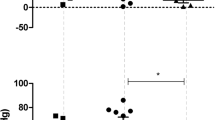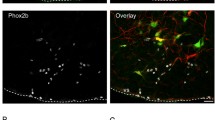Summary
This paper reviews the role of central serotonin-containing neurons in the control of blood pressure. Central serotonin nerves have their cell bodies in the brainstem in a number of discrete collections, from where they ascend to ramify throughout the brain, descend to terminate in the spinal cord, or send shorter projections terminating in medulla, pons, and midbrain. Activation of one important ascending serotonin pathway innervating the preoptic region of the hypothalamus causes an increase in blood pressure. Activation of a bulbospinal serotonin projection descending from the ventrolateral medulla (the B3 cell group) to terminate in the intermediolateral cell column (IML) also evokes a pressor response. This pressor response is independent of that elicited by stimulation of the ventrolateral medulla in the adjacent but separate area containing the C1 adrenaline cell group. The pressor action appears to depend on increased release of serotonin, as detected by microdialysis in the area of the IML, and to be mediated by serotonin receptors of the 5HT1 subclass, probably located on sympathetic preganglionic neurons. It is possible that neuroactive excitatory amino acids, such as glutamate or aspartate, and neuropeptides such as substance P, also play a part in the pressor response evoked by stimulation of the ventrolateral medulla in the area of the lateral B3 serotonin cells. This descending serotonin pathway also appears important in mediating the hypotensive action of the antihypertensive drugs methyldopa and clonidine.
Similar content being viewed by others
References
Twarog BM, Page IH. Serotonin content of some mammalian tissues and urine and a method for its determination. J Physiol 1953;175:157–161.
Bogdansky DF, Pletcher A, Brodie BB, Udenfriend S. Identification and assay of serotonin in brain. J Pharmacol Exp Ther 1956;117:82–88.
Dahlstrom A, Fuxe K. Evidence for the existence of monamine containing neurons in the central nervous system. I. Demonstration of monoamines in cell bodies of brain neurons. Acta Physiol Scand 1964;62(Suppl)232:1–55.
Steinbusch HWM. Serotonin-immunoreactive neurons and their projections in the CNS. In: Bjorklund A, Hokfelt T, Kuhar MJ, eds. Handbook of Chemical Neuroanatomy, Vol. 3, Elsevier, Amsterdam, 1984:68–125.
Loewy AD. Raphe pallidus and raphe obscurus projections to the intermediolateral cell column in the rat. Brain Res 1981;222:129–133.
Loewy AD, McKellar S. Serotonergic projections from the ventral medulla to the intermediolateral cell column in the rat. Brain Res 1981;211:146–152.
Holets V, Elde R. The differential distribution and relationship of serotonergic and peptidergic fibers to sympathoadrenal neurons in the intermediolateral cell column of the rat. Neuroscience 1982;7:1155–1174.
Appel NM, Wessendorf MW, Elde RP. Coexistence of serotonin- and substance P-like immunoreactivity in nerve fibres opposing identified sympathoadrenal preganglionic neurons in rat intermediolateral cell column. Neurosci Lett 1986;65:241–246.
Bacon SJ, Smith AD. Preganglionic neurons innervating the rat adrenal medulla: Immunocytochemical evidence for synaptic input from nerve terminals containing substance P, GABA or 5-hydroxytryptamine. J Auton Nerv Sys 1988;24:97–122.
Smits JFM, Van Essen H, and Struyker-Boudier HAJ. Serotonin-mediated cardiovascular responses to electrical stimulation of the raphe nuclei in the rat. Life Sci 1978;23:173–178.
Kuhn DM, Wolf WA, Lovenberg W. Pressor effects of electrical stimulation of the dorsal and median raphe nuclei in anaesthetised rats. J Pharmacol Exp Ther 1980;214:403–409.
Kuhn DM, Wolf WA, Lovenberg W. Review of the role of the central serotonergic neuronal system in blood pressure regulation. Hypertension 1980;2:243–255.
Smits JFM, and Struyker-Boudier HA. Intrahypothalamic serotonin and cardiovascular control in rats. Brain Res 1976;127:422–425.
Howe PRC, Kuhn DM, Minson JB, Stead BH, Chalmers JP. Evidence for a bulbospinal serotonergic pressor pathway in the rat brain. Brain Res 1983;270:29–36.
Minson JB, Chalmers JP, Caon AC, Renaud B. Separate areas of rat medulla oblongata with populations of serotonin- and adrenaline-containing neurons alter blood pressure and L-glutamate stimulation. J Auton Nerv Syst 1987;19:39–50.
Neumayr RJ, Hare BD, Franz DN. Evidence for bulbospinal control of sympathetic preganglionic neurons by monoaminergic pathways. Life Sci 1974;14:793–806.
Macrae IM, Minson JB, Kapoor V, Morris MJ, Chalmers JP. Midline B3 serotonin nerves in the rat medulla are involved in the hypotensive effect of methyldopa. J Cardiovasc Pharmacol 1986;8:381–385.
Chalmers JP, Angus J, Jennings G, Minson J. Serotonergic mechanisms in hypertension. In: Laragh J, Brenner B, Kaplan N, eds. Perspectives in Hypertension, Vol 2: Endocrine Mechanisms in Hypertension. New York: Raven Press, 1989:241–264.
Pilowsky PM, Kapoor V, Minson JB, West MJ, Chalmers JP. Spinal cord serotonin release and raised blood pressure after brainstem kainic acid injection. Brain Res 1986;366:354–357.
Peroutka SJ, Snyder SH. Multiple serotonin receptors: Differential binding of [3H]5-hydroxytryptamine, lysergic acid diethylamide and spiroperidol. Mol Pharmacol 1979;16:687–699.
Glaum SR, Anderson EG. ICS205930 inhibits high affinity 5HT binding and 5HT stimulated adenylate cyclase in the rat spinal cord. Abstracts Soc Neurosci 1987;13:343.
Mills EH, Minson JB, and Chalmers JP. The effect of intrathecal serotonergic antagonists on the pressor response to stimulation of the brainstem in the rat. Clin Exp Hypertens 1988;A11:265–276.
Ross CA, Ruggiero DA, Joh TH, Park DH, Reis DJ. Rostral ventrolateral medulla: Selective projections to the thoracic autonomic cell column from the region containing C1 adrenaline neurons. J Comp Neurol 1984;228:168–185.
Ross CA, Ruggiero DA, Park DH, et al. Tonic vasomotor control by the rostral ventrolateral medulla: Effect of electrical or chemical stimulation of the area containing C1 adrenaline neurons on arterial pressure heart rate and plasma catecholamines and vasopressin. J Neurosci 1984; 4:474–494.
Guyenet PH, and Cabot JB. Inhibition of sympathetic preganglionic neurons by catecholamines and clonidine: Mediation by an adrenergic receptor. J Neurosci 1981; 1:908–917.
Mills EH, Minson JB, Chalmers JP. Effects of intrathecal administration of methysergide, phentolamine and pindolol on pressor responses to electrical stimulation of the rostral ventrolateral medulla. J Cardiovasc Pharmacol 1988;4:456–460.
Mills EH, Minson JB, Pilowsky PM, Chalmers JP. N-methyl-D-aspartate receptors in the spinal cord mediate pressor responses to stimulation of the RVLM in rat. Clin Exp Pharmacol Physiol 1988;15:147–155.
Mills E, Minson J, Drolet G, Chalmers J. Effect of intrathecal amino acid receptor antagonists on basal blood pressure and pressor responses to brainstem stimulation in normotensive and hypertensive rats. J Cardiovasc Pharmacol 1989, (submitted for publication).
Johansson O, Hökfelt T, Pernow B, et al. Immunochemical support for three putative transmitters in one neuron: Coexistence of 5-hydroxytryptamine, Substance P and thyrotropin releasing hormone-like immunoreactivity in medullary neurons projecting to the spinal cord. Neuroscience 1981;6:1857–1881.
Unger T, Becker H, Petty M, et al. Differential effects of central angiotensin II and Substance P on sympathetic nerve activity in conscious rats. Circ Res 1985;56: 563–575.
Yashpal K, Gauthier SG, Henry JL. Substance P given intrathecally at the spinal T9 level increases adrenal output of adrenaline and noradrenaline in the rat. Neuroscience 1985;15:529–536.
Keeler JR, Charlton CG, Helke CJ. Cardiovascular effects of spinal cord Substance P: Studies with a stable receptor agonist. J Pharmacol Exp Ther 1985;233:755–760.
Takano Y, Martin JB, Leeman SE, Loewy AD. Substance P immunoreactivity released from rat spinal cord after kainic acid excitation of the ventral medulla oblongata: A correlation with increases in blood pressure. Brain Res 1984;291:168–172.
Head GA, Korner PI, Lewis SL, Badoer E. Contribution of noradrenergic and serotonergic neurons to the circulatory effects of centrally acting clonidine and α-methyldopa in rabbits. J Cardiovasc Pharmacol 1983;5:945–953.
Choy V, Chalmers JP. Importance of central serotonin neurons in hypotensive action of methyldopa in the rat. Clin Exp Physiol Pharmacol 1984;11:37–44.
Minson JB, Choy V, Chalmers JP. Bulbospinal serotonin neurons and hypotensive effects of methyldopa in the spontaneously hypertensive rat. J Cardiovasc Pharmacol 1984;6:312–317.
Drolet G, Aslanaian V, Minson JB, Morris MJ, Chalmers JP. Differences in the central hypotensive actions of α-methyldopa and clonidine in the spontaneously hypertensive rat: Contribution of neurons arising from the B3 and the C1 areas of the rostral ventrolateral medulla. J Cardiovasc Pharmacol 1989, in press.
Meeley MP, Ernsberger PR, Granata AR, Reis DJ. An endogenous clonidine-displacing substance from bovine brain: Receptor binding and hypotensive actions in the ventrolateral medulla. Life Sci 1986;38:1119–1126.
Author information
Authors and Affiliations
Additional information
This work was supported by grants from the National Health and Medical Research Council of Australia and from the National Heart Foundation of Australia.
Rights and permissions
About this article
Cite this article
Minson, J., Chalmers, J., Drolet, G. et al. Central serotonergic mechanisms in cardiovascular regulation. Cardiovasc Drug Ther 4, 27–32 (1990). https://doi.org/10.1007/BF00053423
Issue Date:
DOI: https://doi.org/10.1007/BF00053423




